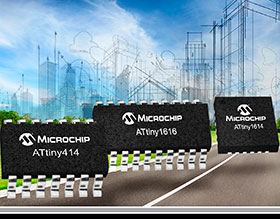New ATtiny MCUs join AVR lineup
22 March 2017
DSP, Micros & Memory

Microchip announced further expansion of its AVR microcontroller (MCU) portfolio with the addition of three new devices to the tinyAVR family. The new ATtiny1617 series of MCUs expands the range of AVR devices that feature core independent peripherals (CIPs), which help to increase system throughput while lowering overall power consumption. The new devices extend the memory offering for these next-generation tinyAVR MCUs with new 16 KB Flash options, while remaining pin- and code-compatible with the recently released ATtiny817 series devices. Furthermore, all members of the family are supported by Atmel START, an online tool for intuitive graphical configuration of embedded software projects.
The new MCUs offer 16 KB Flash, 256 B EEPROM and 2 KB RAM in 14-, 20- and 24-pin packages. The devices contain key features of other tinyAVR MCUs including the event system controller, which allows peripherals to communicate without using the CPU and enables designers to customise the configuration of the MCU for their specific application. The on-chip peripheral touch controller (PTC) simplifies the development of capacitive touch systems. Other integrated features include: a 20 MHz internal oscillator, high-speed serial communication with USART, SPI and I²C, configurable custom logic blocks, a 10-bit analog-to-digital converter (ADC) with internal voltage references, operating voltages ranging from 1,8 V to 5,5 V, and picoPower technology for sleep currents as low as 100 nA.
The new devices are fully supported by the Atmel Studio 7 Integrated Development Environment (IDE), the STK600 platform and Atmel START.
For more information contact Shane Padayachee, Avnet South Africa, +27 (0)11 319 8600, [email protected], www.avnet.co.za
Further reading:
Memory for asset tracking
Altron Arrow
DSP, Micros & Memory
The Page EEPROM, ST’s latest memory, has been designed for efficient datalogging and fast firmware upload/download in battery-operated devices.
Read more...
Engineered for high-reliability applications
Future Electronics
DSP, Micros & Memory
The MCX E series of Arm Cortex-M4F and Arm Cortex-M7 microcontrollers from NXP are engineered for demanding industrial and IoT environments.
Read more...
NXP’s development platform guide
DSP, Micros & Memory
Choosing between the FRDM i.MX 93, FRDM i.MX 91 and FRDM i.MX 91S development platforms can be intimidating, but once designers understand how each platform aligns with their application’s requirements, the decision becomes straightforward.
Read more...
XJTAG launches two new Flash programmers
ASIC Design Services
DSP, Micros & Memory
XJTAG has announced XJExpress and XJExpress-FPGA, a pair of Flash programmers perfect for development, debug and in-service applications.
Read more...
Processor offers competitive solution for advanced HMIs
Future Electronics
DSP, Micros & Memory
The new RZ/A3M microprocessor from Renesas features 128 Mbytes of fast DDR3L DRAM memory for system cost reduction, and supports
1280 x 800 px video resolution at a rate of 30 frames/s.
Read more...
ESP32-C6 achieves PSA-L2
iCorp Technologies
DSP, Micros & Memory
Espressif Systems recently announced that its ESP32-C6 microcontroller has achieved PSA Certified Level 2 (PSA-L2) security certification, making it the first RISC-V-based MCU to reach this level.
Read more...
Microprocessor with integrated NPU
Avnet Silica
DSP, Micros & Memory
The RZ/G3E from Renesas is a microprocessor integrated with quad CPU and NPU in one chip, improving power efficiency, reliability, and security.
Read more...
Nordic Semiconductor launches nRF Connect SDK Bare Metal option for nRF54L series
Avnet Silica
DSP, Micros & Memory
This is a new, RTOS-independent software solution for Bluetooth LE development, designed to ease developers’ migration from the legacy nRF5 SDK and nRF52 series to the next-generation nRF54L series.
Read more...
Dual-core support in NECTO Studio
DSP, Micros & Memory
MIKROE recently announced that version 7.3.0 of its NECTO Studio Integrated Development Environment now supports dual-core MCUs, allowing designers to program and debug each core independently.
Read more...
Post Quantum Cryptographic firmware library
DSP, Micros & Memory
The STM32 post-quantum cryptographic library enables developers to satisfy application requirements for any combination of data integrity, confidentiality, identification/authentication, and nonrepudiation.
Read more...


